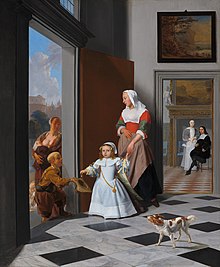

Voorhuis painting (English: entrance hall painting) was a Dutch painting genre of the 17th century, typically portraying a view from inside a wealthy house with affluent residents interacting with patrons on the outside through the front doorway. Voorhuis describes a front room, vestibule, or foyer in Dutch.
The style may have developed as a result of the "good light" which streamed through the front windows of a house, while the side walls of Dutch townhouses were often windowless.
Jacob Ochtervelt was a key artist of the movement. Many of Ochtervelt's voorhuis pictures illustrated the trade between residents and local peddlers and food vendors. Het Binnenhuis by Pieter de Hooch is considered an excellent example of the voorhuis style.
References
- Liedtke, Walter A.; Plomp, Michiel; Rüger, Axel; N.Y.), Metropolitan Museum of Art (New York; Britain), National Gallery (Great (2001). Vermeer and the Delft School. Metropolitan Museum of Art. ISBN 978-0-87099-973-4.
- Franits, Wayne E. (2004-01-01). Dutch Seventeenth-century Genre Painting: Its Stylistic and Thematic Evolution. Yale University Press. ISBN 978-0-300-10237-6.
- Fleischer, Roland E.; Munshower, Susan Scott (1988-01-01). The Age of Rembrandt: Studies in Seventeenth-century Dutch Painting. Penn State Press. p. 103. ISBN 978-0-915773-02-2.
- Jacobs, Lynn F. (2017-09-25). Thresholds and Boundaries: Liminality in Netherlandish Art (1385-1530). Routledge. ISBN 978-1-351-60873-2.
- Funk, Elisabeth Paling; Shattuck, Martha Dickinson (2011-09-07). A Beautiful and Fruitful Place: Selected Rensselaerwijck Papers, Volume 2. State University of New York Press. ISBN 978-1-4384-3597-8.
This art movement–related article is a stub. You can help Misplaced Pages by expanding it. |
This Netherlands-related article is a stub. You can help Misplaced Pages by expanding it. |